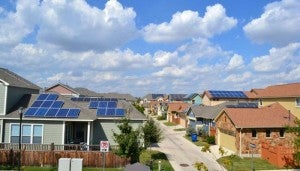 Thanks to improvements in technology, it’s easier than ever to be green.
Thanks to improvements in technology, it’s easier than ever to be green.
Solar panels and electric vehicles (EVs) are two prime examples of technologies that can help people minimize their environmental footprint, without sacrificing comfort or having to radically change their daily behavior. But the question still remains: How much of an environmental benefit do these technologies actually produce? And, are there actions that owners of these technologies can take to minimize their pollution footprint even more?
A new paper by my colleagues and me, recently published in Energy Economics, attempts to answer these two questions for households in Austin, Texas. These homes are part of Pecan Street Inc., a living smart-grid laboratory with the largest customer energy-use database on the planet. Using detailed household-level data from 2013-2015, we were able to track solar panel performance and EV use and charging patterns, and match these actions to two important environmental impacts: water use and greenhouse gas (GHG) emissions.
Our paper confirms that, in Texas, residential solar panels uses less water and pollutes the air less than using the central-grid power (based on its electricity sources during those years), and driving an EV instead of a gasoline vehicle generally reduces the household’s water and emission footprint, even though EVs charge from the grid. Moreover, our analysis demonstrates how carefully examining energy-use data can help us make sure we’re maximizing clean energy’s benefits. Read More










 New York is on the path to transforming its electric industry. Since the
New York is on the path to transforming its electric industry. Since the 


